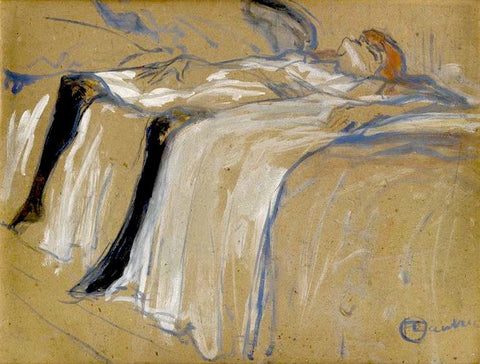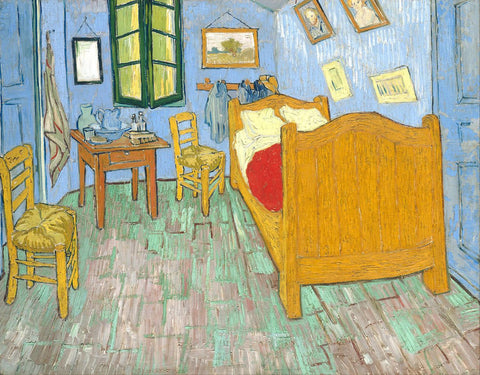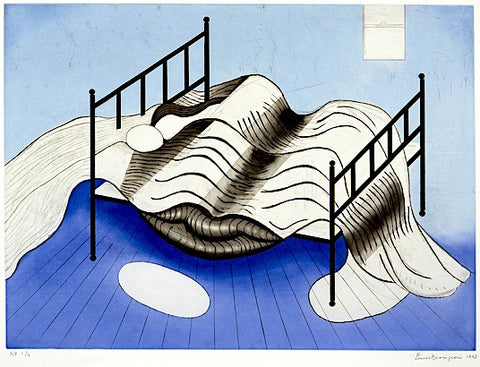
The Annunciation by Rogier Van der Weyden, painted in oil on oak panels, would have been the central part of a triptych executed by the painter around 1440.
The scene takes place in an opulent interior. Marie, with her hair loose, sits on the floor in front of a desk and reads. Gabriel is standing in front of her, covered in a richly embroidered golden cape. The divine character is less obvious here because it is inscribed in a very learned codification. Several elements recall Christ: the vine leaves on the angel's clothing ("I am the vine"); the extinguished candle awaits the light of the Savior; the medallion in the canopy represents Christ in majesty; the pomegranate symbolizes both Passion and fertility.
Other elements are a tribute to Mary: the three open flowers of the lily symbolize the three states of Mary's virginity (before, during and after); the stars formed by the paving remind us that Mary is the morning star; the transparent vial represents miraculous birth and virginity. Other symbols can still be identified: the basin and the ewer represent purification by water; the lions on the armrests recall those of Solomon's throne; the dragons in the chandelier embody Evil.

“The Conception of Merlin”, France, 1450. Let’s see, it’s still more than 570 years old… Ultra contemporary.

A famous illumination, "How Merlin was fathered by the devil. And how he was in love with the lady of the lake". From the book Lancelot of 1494.
Toussaint Dubreuil, (1561 - 1602), "Sleeping Love".
The sleeping young man does not have the wings of Love but only, next to his bed, his bow and arrows. These attributes are also those of Apollo. The character who climbs onto the bed seems drunk, on wine or on love? In the background, a violent scene quite strange to illustrate love. The use of blue prepared paper was a nice method used then.

Jean-Honoré Fragonard, “The Lock”, 1777.
Simple genre scene, in the saucy spirit of the late Ancien Régime period, or a moralizing historical painting which intentionally upsets the hierarchy of genres. At first glance, it is a gallant scene: a woman weakly resists the amorous ardor of her lover who closes the bedroom lock. The work is full of intriguing details, each more symbolic than the last. If we stick to the logic of the moment, the man who closes the door has not achieved his goal. A question then crosses our minds: why is the room already in disorder? In this disturbing context, certain objects reveal all their symbolism to evoke eroticism.

Eugène Delacroix, “An Unmade Bed”, 1827. Sublime!

Henri de Toulouse-Lautrec, 1896.
Work by the Hungarian, József Rippl-Rónai, from 1900, it's a pleasure, isn't it?
Absolute masterpiece by Pablo Picasso, "The Blue Room", 1901. Picasso demonstrates his admiration for Henri de Toulouse-Lautrec in this painting from the blue period. On the wall, above the bed, is a poster that Toulouse-Lautrec made for the English dancer May Milton for an American tour which ultimately never took place.
For this poster, Toulouse-Lautrec used only five colors, saturating the background with blue and using the white of the paper for Milton. (see next post)
How on earth did Picasso learn about this poster of which only a few prints are known?
A room, the most beautiful and how modern to date from 1905.
“Interior in Collioure”, Henri Matisse.
Kees van Dongen, "The Pink Dress", 1919.
On January 26, 1877, Kees Van Dongen was born. In 1892, he entered the School of Decorative Arts in Rotterdam.
He arrived in Paris in 1897 and led a miserable existence in Montmartre. He collaborated with L'Assiette au Beurre and other satirical weeklies and became known for his caricature drawings.
He began exhibiting in 1904 at Vollard. In 1905, he exhibited at the Salon d'Automne, where the bright colors of his works were, along with those of Vlaminck and Matisse, the origin of the name of a group of painters: the "Fauves".
After the First World War, Kees Van Dongen began a career as a portraitist of Parisian society. Decorated with the Legion of Honor in 1922, he finally obtained French nationality in 1928.
Kees Van Dongen died at his home in Monte-Carlo in 1968.

Pierre Paulus, “The Red Bedspread”.
It was this Belgian painter who drew, in 1913, the rooster which appears on the Walloon flag, colloquially called the bold rooster.

Suzanne Valadon, “The Blue Room”, 1923.
What a painter and what a woman! She was one of the first women admitted to the National Society of Fine Arts, in 1894, and embodies a tremendous freedom in her life as in her work. Daughter of a linen worker from Limousin, she was first an acrobat then a model for Puvis de Chavannes, Renoir and Toulouse-Lautrec, before becoming a self-taught painter. She is the mother of Maurice Utrillo.

Henri Matisse, “Reclining Nude”, 1927.

Augusto Giacometti, “My hotel room in Paris” 1938
Henri Matisse, paralyzed, drew the figures of the Vence chapel on the walls of his room-studio in the former Hôtel Régina, in Nice.
Francis Bacon, “Portrait of Henrietta Moraes”, 1963.
Louise Bourgeois, "Blue Bed", engraving published in only 21 copies in 1998.
And to conclude, what would a “Lit” series be without “Vincent Van Gogh’s Room in Arles”

In Arles, where he settled in February, he rented the "yellow house" and created paintings to decorate the walls, such as the famous Sunflowers. His room even became the subject of a painting, of which he would later provide two other versions. This was carried out in 1889, while he was interned in the psychiatric hospital of Saint-Rémy-de-Provence. He painted it especially to give it to his mother. A letter to his brother Théo sheds light on his intentions: “The sight of the painting should rest the head or rather the imagination,” he wrote. The artist who is going through a difficult period clearly appears in search of appeasement. Through this work, he wants to suggest the rest to which he aspires and seeks to calm the torments that assail him. Only the strange perspective which defines the space of the room reveals an instability, a disquiet: the furniture seems to float in the room, the bed, deformed, slides towards the viewer.

Many artists, and more particularly painters, make a subject their own, sometimes banal, they decline it, persist and go to the point of obsession, seeking to capture the different lights over the hours of a day or wanting to represent a changing and subtle atmosphere. Claude Monet, from 1892 to 1894, produced 30 paintings of the facade of the cathedral in Rouen. In 1955, inspired by Eugène Delacroix, Pablo Picasso painted a series of fifteen paintings "Women of Algiers" and before that, 92 preparatory drawings. Between October 1888 and 1889, Vincent van Gogh chose the banal decor of his room in Arles. The first version of the painting presents, above the bed, the portrait of the painter Eugène Boch and the portrait of second lieutenant Paul-Eugène Milliet.
Van Gogh will create two other versions of this painting. The first having been damaged by a flood of the Rhône. Van Gogh painted the second version in 1889 of his bedroom. Vincent van Gogh then hangs a self-portrait and a female portrait above the bed. Encouraged by the result, Van Gogh created a third version as a gift to his sister. In this version, the portrait of Eugène Boch is replaced by the self-portrait without a beard, the other painting does not resemble any known painting. Both are elaborately painted.
Excerpt from a letter from Vincent Van Gogh to his brother Théo.
“The walls are a pale purple. The floor is red tiles.
The wood of the bed and the chairs are fresh butter yellow.
The very light lime sheet and pillows. The scarlet red cover.
The green window. The orange dressing table and the blue basin. The lilac doors.”

"Bedroom at Arles", 1992, by Roy Lichtenstein, is a huge and pop interpretation of van Gogh's "Bedroom in Arles."
We find the same layout as van Gogh's work but the furniture has had a little facelift!




















